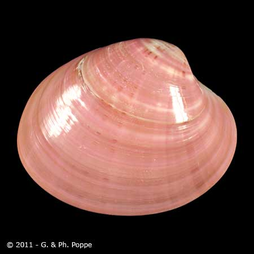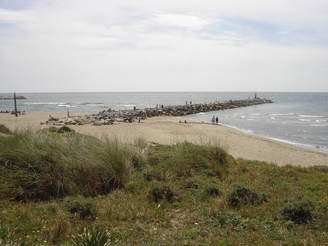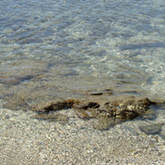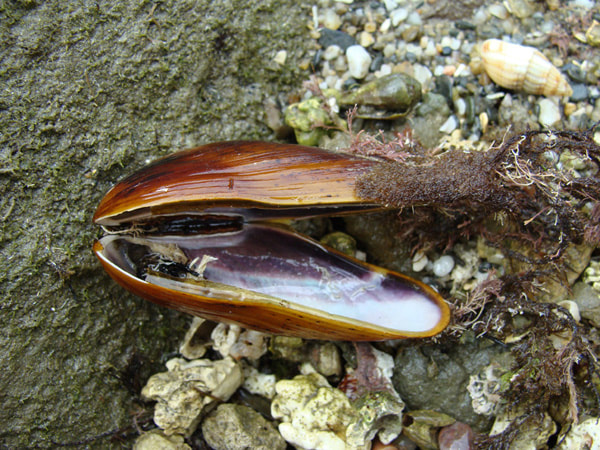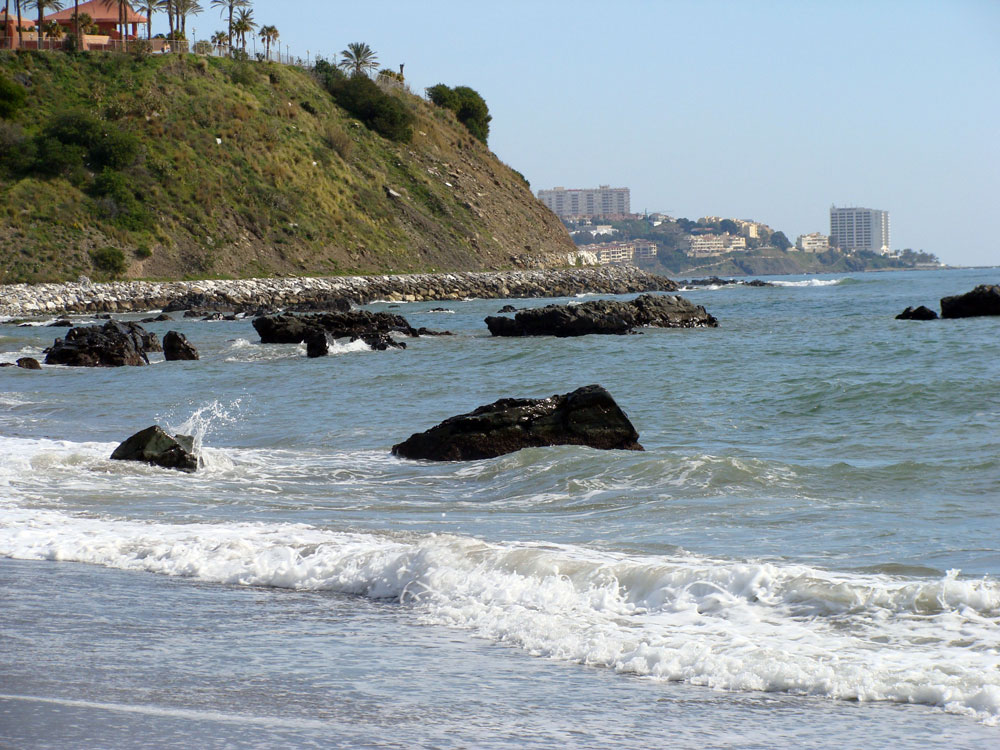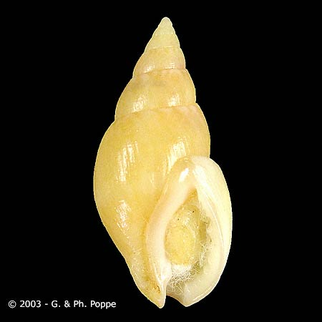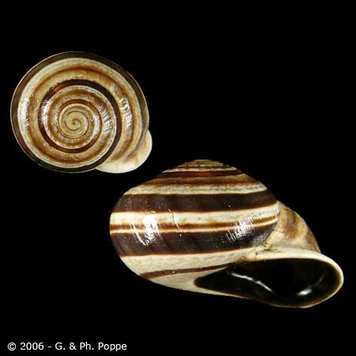Shell collecting in Andalucia
by Carl Ruscoe
Photographs courtesy of Conchology, Inc. and Juan Sebastian Torres Alba
Photographs courtesy of Conchology, Inc. and Juan Sebastian Torres Alba
In October 2013 my brother Craig and I flew to Malaga to spend 10 days collecting shells in the south of Spain. Craig had previously spent one week in the area in May looking for shells and had some success, particularly at the small fishing port of Estepona to the east of Marbella. On this occasion we arranged to meet a local collector whom we had met through Facebook. This local collector is Juan Sebastian Torres Alba, known to his friends as Sebas. Sebas has lived all his life in Malaga and has collected and studied shells in the area for most of his life. He has an excellent knowledge of the local mollusc species. His knowledge would prove to be of great help to us during our stay.
We arrived in Malaga on the evening of the 1 October. Our hotel in Torremolinos seemed to be quite nice and modern, although our rooms did not have a much-needed balcony, a problem which we would have to overcome with the help of Sebas. The next morning we met Sebas at the Malaga Centro Alameda station and we could see immediately that he was a very friendly and enthusiastic person, someone we could get along with very easily. Sebas took us to the harbour to look for shells left behind by the fishing trawlers. We found a lot of shells amongst nets and in octopus traps. Most of the shells were of common species including Nassarius reticulatus, Nassarius incrassatus and Ocenebra erinacea. We did find some more uncommon species here including two very large specimens of Nassarius elatus, a smoother and more elongated species of Nassarius which we had not previously collected.
We then walked to the fish and food market in the city centre. In May 2013 Craig had purchased a good number of Callista chione here and some of the specimens were a beautiful dark pink colour. This outstanding colour form is seemingly only found in the seas around the Costa del Sol. Unfortunately, there were only a few pink specimens available on this occasion. We did however find Venus verrucosa for sale on two of the stalls and many of these specimens were marked with a beautiful dark pink colour on the concentric lamellae (frills). We have not seen such coloration before in this species. We were delighted to find these shells for sale.
Sebas then took us to his home where we had a good look at his collection. His collection is very impressive. He has about 6,000 species, about equally divided between marine and non-marine species. It was very difficult to appreciate his extensive collection in just a few hours but it was refreshing to see so many species that we had not seen before. So many of his non-marine snails, in particular, are extremely local and many are endemic to one island or even one mountain or one small stream or fountain, etc.
In my experience, many collectors collect particular species because they are so-called collector’s items and then in time, most collectors have such species in their collection and then they fail to impress the viewer in the way they were intended to. I am equally impressed to see species that are less well documented and so it was wonderful to see so many obscure and interesting species in Juan’s collection.
The following day we took a taxi to the beach at Benalmadena. In May 2013 Craig collected some very nice material here including two specimens of Pseudotorinia architae, a rare species of Sundial snail in the family Architectonicidae. Although we arrived early for the "low tide", the tide was much higher than it was during Craig’s previous visit and so it was very difficult to collect anything at all. We collected just a few specimens of interest here including a nice specimen of Dentiscala crenata.
We then walked east to check the beach at the western end of Torremolinos. On a drift line here we found many land and freshwater shells which had been washed out of one of the streams. The shells in the drift consisted mostly of a few very common species, but there were also several interesting Hygromiid species and several nice Zonitids (Glass snails) in the drift. We walked the length of La Carihuela beach until we arrived at an interesting rock formation at the eastern end. Here amongst weeds at the base of the rock is a habitat for several locally common species of snails and many wild cats. We collected many nice specimens of Iberus marmoratus here, the most common and widespread Iberus species in the Malaga Province, but possibly also the most beautiful. I also found the exoskeleton of a huge hornet which was well over an inch in length.
Early on Friday morning Sebas picked us up in Torremolinos and we set off to check some of the beaches near Marbella. Marbella is the second largest city in Malaga Province. We stopped off at the harbour in Marbella to see what we could find. There were not many shells at the harbour, but we did collect a few from fishing nets including one nice specimen of the European Carrier shell, Xenophora crispa. Sebas also collected several live specimens of Bolma rugosa in shallow water at the edge of the jetty. This is a beautiful species with a beautiful orange columella and operculum.
We then proceeded to the beach where Sebas began his collecting as a child, a wonderful little place called Las Chapas. The beach here consists of inter-tidal rocks with small area of sand between the rocks. In the shallow water here we found many small specimens of the common Carpet shell, Venerupis geographica, known to most British collectors as V. pullastra or V. corrugata. The variation in this species here is remarkable, with specimens being found with very little sculpture, while other specimens have quite pronounced concentric lamellae at the posterior so that they almost resemble another common Venerid species, Irus irus. There are also distorted specimens which can be labelled as the form "saxatilis". The colour and pattern of these Carpet shells here varies considerably also, with some specimens having a deep pink or bluish cast. Another very nice find here was several complete specimens of Ungulina cuneata, a very strange and uncommon bivalve.
Our next stop was a beach called Cabopino. Cabopino is a larger beach with less rocks and more extensive areas of sand. Sebas told us that the shell grit here is very good for very small micro shells. Sebas took us to the only area of the beach where shell grit was accumulating at the shore line. The area was just a few metres wide. Using my sieve I collected about half a sack of this shell grit to sample later. Some slightly larger shells could also be found here including more Venerupis and Irus and a few Ungulina cuneata.
Cala de Mijas was the third beach we sampled that day. Sebas has collected many nice shells on this beach. The beach is usually good for collecting Modiolus lulat, a species of mussel with a rather inflated shell. I had collected this species in Senegal but never before in the Mediterranean. There were far fewer shells on the beach than usual, according to Sebas. We did collect a few good specimens of Modiolus lulat, however, and some beautiful specimens of Natica vittata with striking patterns.
Our final stop in the afternoon was at Carvajal. Carvajal is a very rocky beach where a reasonable number of shells can usually be found, although it is rarely prolific, according to Sebas. Our only notable find here was a small specimen of Patella nigra.
The following morning Craig and I took the train to Malaga and made a second visit to the fish market, hoping that there were fresh catches for sale. We purchased a few more Callista chione and some more outstanding specimens of the Warty Venus shell. It was difficult though because it was so busy and some of the fishmongers took exception to me sifting through the shells with my hands. I very much doubt that Spaniards eat the shell as well as the mollusc so I was a little bemused by their aggressive attitude towards me, but had to respect their wishes and move on.
We walked all the way to Benalmadena in the afternoon only to find that the tide was even higher than before and collecting was virtually impossible, so we began the long walk back to the hotel which included climbing 182 steps up to the centre of Torremolinos. These steps were like something out of a bad dream. Seemingly wherever you walked around this part of the coastline, you would end up at the bottom of these steps!
On the Sunday we decided to take the train inland to a small town called Alora. The station here is separated from the town centre and along with the few houses nearby it is like something out of a Spaghetti Western. We walked up a steep path across the main road from the station and collected just a few species here including Otala lactea, a very common species which can be found in many parts of Andalucia without any real effort, and Iberus marmoratus in reasonable numbers. We also checked the flood plain of the river here for dead freshwater shells but no shells could be found, possibly due to a lack of calcium carbonate in the water. Sebas later informed us that about three miles from Alora at El Chorro there is a small area of limestone and many snails can be found there, but at Alora itself the base rock is not calcareous so there is not a good diversity of species there.
We met Sebas very early the next morning and as arranged we set off on a long drive to Getares, on the far side of Gibraltar. He stopped at a point called Faro Punta del Carnero. He had collected many nice shells here previously and so he was confident that we could find some nice things here. Amongst the weeds on the path down to the beach we found one rare and local species of Oestophora, a flattened and tightly coiled genus of land snails in the family Trissexodontidae. We also found Pseudotachea litturata in the same habitat, another rare species of snail with a limited range in Cadiz Province and in Northern Morocco.
At first the beach did not inspire me, but as we lifted the rocks at the shoreline we found many nice micro shells trapped under the rocks. As we walked on we found hundreds of hermit crabs on the inter-tidal rocks with a good variety of shells. We began to find more and more small shells as we checked the areas between the larger rocks including several species of Epitoniidae, Columbellidae, Nassariidae, Trochidae and Cystiscidae. Gibberula oryza could be found here in good numbers with fantastic banded shells. Craig found one perfect and large specimen of a rare wentletrap called Epitonium pulchellum. Nassarius corniculus was particularly variable here with a range of colour forms and patterns: amazingly, specimens could be found here with pronounced radial ribs, but only at the southern end of the bay! The specimens found at the northern end of the bay were all of the common smooth form but with more variable coloration with a few specimens being yellow. Nassarius cuvieri could also be found here with beautiful patterns.
As I carried about 20kg of shell grit back up the steep path to the road, Craig and I both agreed that this was the most productive beach we had visited in Europe. We conveyed our thoughts to Sebas, who was also very pleased with his visit to this beach and pleased that we had found so many nice shells here.
We drove towards Algeciras and stopped at another beach about 1km away from Faro Punta del Carnero. The only species that could be found here were the common species living there on the rocks. The False limpet, Siphonaria pectinata, was particularly abundant here. Because of ocean currents and other factors it is often the case that one beach can be so productive and another beach so close by can yield so few species.
Sebas then drove us in to the hills not far from Estepona to look at the land snail fauna there. We stopped near a place called La Utrera, near Manilva. There is a sulphurous stream there which has been named as a "Roman Oasis". The stream contains high concentrations of sulphides, which give it an amazing blue-grey colour and supposedly give the water healing properties. People come to bathe in the stream from miles around hoping that it will help their health – whether it does or not remains to be seen.
On the limestone rocks and walls here lives the species Candidula gigaxi and a closely related species which was discovered by Sebas, which has not yet been described. The undescribed species is currently undergoing analysis and will probably be placed in the genus Xerocrassa, in the family Hygromiidae. We helped to collect a few live examples of this species to be sent off for analysis. Sebas also discovered a new species of Platyla here (Family: Aciculidae) in leaf litter much higher up the mountain path. He showed us where it was found and collected a small sample of leaf litter from the habitat.
We finally arrived at Estepona later that afternoon and began to search around the nets and in the octopus traps on the jetty. There were far fewer shells to be found here than during Craig’s previous visit in May. It is even possible that these octopus traps had not been submerged in the ocean since Craig had cleaned them out back in May. We found a few nicely patterned specimens of Paphia rhomboides and a few other nice shells including a large and perfect specimen of Glycymeris insubrica. On the far side of the harbour we collected a good specimen of Ranella olearium, Phalium granulatum undulatum and several specimens of Acanthocardia tuberculata, including two albino specimens. In May 2013 Craig found many more nice shells here including Fusinus, Cancellaria, Glycymeris, Callista, Xenophora, Calliostoma, Bolinus, Nassarius, Turritella, Mesalia and four species of Acanthocardia. It seems as though the specific fishing for octopus could be seasonal and therefore the octopus traps might stay for long periods in the harbour before they are used again. This is something to consider when planning a visit to the harbour at Estepona.
Tuesday was almost entirely spent cleaning shells in preparation for the flight home. Roughly 40kg of sand and rubble had to be carried to the beach at Torremolinos to be dumped amongst the rocks at the far end of the beach. There was no escaping the infamous steps to get back to the hotel.
On our final full day of collecting in the area, Sebas drove us inland to look for two species of Iberus. The first species that we looked for was Iberus loxanus. Iberus loxanus is a very rare and local species of snail. It has a wide, relatively flat shell with a rounded margin and a finely reticulated surface. We found several specimens under ledges at the base of the limestone cliffs.
Another interesting species to be found here was Xerocrassa jimenensis, a small flattened species of Hygromiid similar to Candidula. We then walked deeper into the area to look for a second species of Iberus, Iberus rositai. Iberus rositai is very similar to the closely related Iberus loxanus but it has a keeled shell. The keel on the margin of this species is not too sharp and in some specimens it is difficult to distinguish between the two species. Iberus rositai lives in deep crevices within the rock, making it difficult to collect live specimens. Fortunately we found many dead specimens of Iberus rositai, with several of them being quite fresh. In fine deposits of soil and leaf litter here, we also found Pyramidula jaenensis, a very interesting and local micro snail. Chondrina calpica was very common here, living in large colonies on the limestone cliff faces.
Sebas then drove us to Valle de Abdalajis to look for Iberus cobosi, undoubtedly the rarest snail we would find during our stay. Iberus cobosi is restricted to one slope of one mountain in the Malaga Province. Without the help of a local collector, it would be practically impossible to find such a species of snail. As we arrived at the base of the mountain, we found the species Xerosecta promissa to be abundant, living on weeds and even in the trees there. There was a pleasing variety of patterns and colour forms within this population of Hygromiid snail which closely resembles the more common Cernuella virgata. As we climbed the steps up the mountain side we began to find Otala lactea and Iberus marmoratus with its beautifully patterned and smooth shell. The shells of the Iberus marmoratus gradually changed in form as we ascended up the mountain side. We began to find specimens with a blunt keel developing near the shoulder of the body whorl and quite pronounced radial sculpture on the top of the shell. The shape of the specimens in this population was also found to be unusually variable with some shells being slightly distorted.
As we climbed higher we began to find the target species, Iberus cobosi. Iberus marmoratus disappeared and Iberus cobosi took its place. Iberus cobosi is a remarkable species with pronounced radial sculpture throughout the shell and a sharp keel at the periphery of each whorl. We found living specimens in crevices within the rock and a good number of empty shells could be found at the base of the rocks. We collected about 20 good dead specimens and Sebas collected many more. As we climbed still higher up the mountain side, Iberus cobosi became much more sporadic and Xerosecta promissa became the dominant species once more, with very large specimens being common.
I found it remarkable how the species of snail on this mountain side have their own little niches, when there are seemingly only subtle differences in the habitats for each species. What is also remarkable is how a species such as Iberus marmoratus, which almost always has a smooth shell, produces a strange keeled and sculptured form in its habitat here, a habitat which is so close to the habitat of the strongly keeled and sculptured Iberus cobosi. I think it is likely that something in the habitat or perhaps the diet of the snails here is affecting the form of the shells. I do not know if there has been much research into the Iberus here but this is something which I would like to look into.
Sebas is currently working alongside other experts on an extensive study of the Iberus species in the Andalucia region and so more information and answers might be found in the future. On the descent down the mountain slope I collected some soil and leaf litter deposits which contained Cecilioides acicula and Truncatellina callicratis. We also turned over many rocks to look for scorpions, but unfortunately none could be found. I was disappointed to not find any scorpions but also relieved that no one was stung by one. Looking for such a dangerous animal could be like waiting for Doctor Underhill.
We said our goodbyes to Sebas and thanked him for all his help during our stay. Our experience of collecting shells with Sebas was one we enjoyed very much and his knowledge of collecting in the area proved to be priceless to us. With the recent development of social networking sites it is now much easier to contact collectors overseas and arrange to go collecting with them, something which I strongly recommend.
On our final day in Torremolinos, we walked east to Los Alamos where we found very little on the beach. The far end of the beach here is a nudist beach, something which we didn’t know beforehand. If we had known we would not have walked on the beach there and been mentally scarred by the horrific sights that were forced upon us. Behind the beach at Los Alamos was some waste ground and amongst the plants there were many dead shells of snails including many nice specimens of Cochlicella conoidea. This species is far less common than the other species in its genus and it is restricted to a much smaller range of distribution. This species can be found on sand behind the beach at Las Chapas and Cabopino but at Los Alamos it is living in a much larger population and is seemingly unrecorded there.
Our flight back to England that evening went without any problems and at Manchester we were relieved to step out into the cool air after 10 days of unforgiving heat.
We are still in the process of sorting through the shell grit and leaf litter that we collected and recording our finds. I have made a preliminary list of species found during our stay. I will update the list at a later stage and send our findings to the webmaster. If anyone wants any more information about our trip and what we found then please email Carl Ruscoe.
I would like to express my grateful thanks to Philippe Poppe of Conchology, Inc. and Juan Sebastian Torres Alba for their kind permission to use their photographs.

